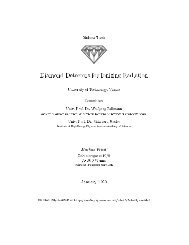Create successful ePaper yourself
Turn your PDF publications into a flip-book with our unique Google optimized e-Paper software.
information about an event that is available to the higher levels of the system, theyprovide a useful probe for testing.One notable missing piece in the readout record is the algorithm bit information asgenerated by the GTL. Since the GTL has no separate readout channel, the readoutrecord only contains the algorithm bits after FDL processing, which includes applicationof the prescale factors. This has some adverse consequences for the reprocessingof data.Execution ModesThere are two subtypes of function tests which use the same input and rely on similarverification methods, but differ slightly in the method of L1A generation.GT/GMT Function Test For the GT/GMT function test, the L1A signal that causesthe readout is generated through the test trigger mechanism of the TCS. This allowsthe generation of the L1A at a fixed bunch crossing within each orbit. Since thereadout contains at least three bunch crossings, the entire simulated LHC orbit isexamined by stepping the test trigger from bunch crossing 1 to 3563 in increments of3 and extracting the associated readout records for each.The output data from a GT/GMT function test thus consists of 1188 DAQ readoutrecords and 1188 EVM readout records.FINOR TestThe GT/GMT function test is defined to mostly bypass the FDL logic - prescalingand masks are set to trivial values, and the FINOR word is intentionally forced tozero - the L1A signal is generated through the test trigger mechanism. In the FINORtest, the L1A is generated through the normal mechanism involving the FDL andTCS boards and the TTC system. While this extends the test coverage, it has thedisadvantage of making the output more unpredictable due to the nature of the GTFEspy memory, which can currently capture only one readout record before it needs tobe reset. Since the bunch crossing number within the orbit when the test is started isunpredictable, the resulting readout record contains the first event after the start ofthe test to generate an L1A with the current settings.Extending this test to the case where multiple events in the orbit would have triggeredan L1A in an efficient manner is difficult since repetition of the test is increasinglylikely to simply cause a repeat of a former run. For the time being, the FINOR testthus simply runs once and produces one DAQ and EVM readout record each perexecution.Output VerificationThe output readout records are analyzed in two different respects:57












